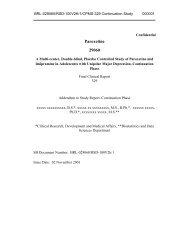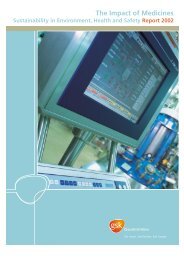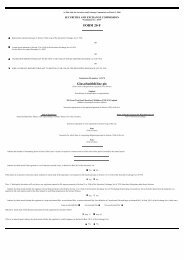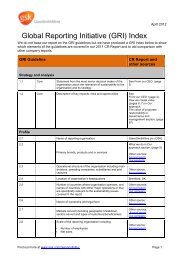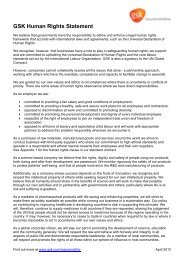GSK Annual Report 2002
GSK Annual Report 2002
GSK Annual Report 2002
You also want an ePaper? Increase the reach of your titles
YUMPU automatically turns print PDFs into web optimized ePapers that Google loves.
37 Reconciliation to US accounting principles continued<br />
Merger transaction costs<br />
Glaxo Wellcome incurred total merger-related transaction costs of<br />
£66 million, excluding integration and restructuring costs. Under UK<br />
GAAP these merger transaction costs were expensed as incurred<br />
during 2000. Under US GAAP, direct acquisition costs of the<br />
acquiring company are included as a portion of the purchase<br />
consideration.<br />
Restructuring costs<br />
The requirements for recording a provision for restructuring costs<br />
are different in certain aspects under US GAAP than under UK<br />
GAAP. Accordingly, adjustments have been made to eliminate the<br />
UK GAAP provisions for restructuring costs that do not meet US<br />
GAAP requirements.<br />
Marketable securities<br />
Marketable securities consist primarily of equity securities and<br />
certain other liquid investments. Under UK GAAP these securities<br />
are stated at the lower of cost and net realisable value. Under US<br />
GAAP these securities are available for sale under Statement of<br />
Financial Accounting Standard No 115 (SFAS 115) ‘Accounting for<br />
certain investments in debt and equity securities’ and are carried at<br />
fair value, with the unrealised gains and losses, net of tax, reported<br />
as a separate component of shareholders’ equity.<br />
Pensions and other post-retirement benefits<br />
The key differences between UK (SSAP 24) and US GAAP in relation<br />
to defined benefit pension plans are:<br />
• under UK GAAP the effect of variations in cost can be<br />
accumulated at successive valuations and amortised on an<br />
aggregate basis. Under US GAAP the amortisation of the<br />
transition asset and the costs of past service benefit<br />
improvements are separately tracked: experience gains/losses<br />
are dealt with on an aggregate basis but amortised only if<br />
outside a 10 per cent corridor.<br />
• UK GAAP allows measurements of plan assets and liabilities to<br />
be based on the result of the latest actuarial valuation. US GAAP<br />
requires measurement of plan assets and liabilities to be made<br />
at the date of the Financial statements or up to three months<br />
prior to that date.<br />
• The pension adjustment also includes the impact of changes in<br />
minimum pension liabilities included within accumulated other<br />
comprehensive income.<br />
During <strong>2002</strong>, the Group decided to align the measurement date<br />
for all of its pension plans to 31st December as certain of the<br />
Group’s plans had a measurement date for pension assets and<br />
liabilities of 30th September.<br />
The impact, reflected as a cumulative effect of an accounting<br />
change, was a £37 million credit, net of tax, to income.<br />
The disclosures required by SFAS 132 are included in this Note.<br />
Stock-based compensation<br />
Under UK GAAP share options are accounted for as equity when<br />
exercised, valued at the issuance price. Under US GAAP, the Group<br />
applies SFAS 123 ‘Accounting for stock-based compensation’ and<br />
related accounting interpretations in accounting for its option plans<br />
which require options to be fair valued at their grant date and<br />
included in profit and loss over the vesting period of the options.<br />
Notes to the financial statements GlaxoSmithKline 123<br />
As a result of the merger certain of the Group’s options vested<br />
immediately requiring the acceleration of compensation expense.<br />
The amount of stock-based compensation expense related to this<br />
accelerated vesting was £83 million in 2000. The disclosures<br />
required by SFAS 123 are included in Note 34.<br />
Additionally, the Group is entitled to receive a tax deduction for the<br />
amount treated as compensation under US tax rules for employee<br />
stock options which have been exercised by US employees during<br />
the year. Under UK GAAP this is treated as a reduction of tax<br />
expense whereas under US GAAP a portion of this amount is<br />
credited to equity.<br />
Employee Share Ownership Trust (ESOT)<br />
Under UK GAAP shares of the Group’s stock held by the ESOT<br />
are recorded at cost, less a provision representing the difference<br />
between the cost and the option exercise price, and accounted for<br />
as fixed asset investments. Projected losses on the exercise of the<br />
options covered by the shares are recorded through the profit and<br />
loss account over the life of the options. Under US GAAP shares of<br />
the Group’s stock purchased by the ESOT are accounted for within<br />
shareholders’ equity at cost. Gains or losses arising on subsequent<br />
issuance of the shares to employees to satisfy share options are<br />
recorded as adjustments to shareholders’ equity.<br />
Derivative instruments<br />
Statement of Financial Accounting Standard No. 133, ‘Accounting<br />
for Derivative Instruments and Hedging Activities’ (SFAS 133) as<br />
amended by SFAS 137 and SFAS 138 and as interpreted by the<br />
Derivatives Implementation Group, was adopted by the Group with<br />
effect from 1st January 2001. SFAS 133 establishes accounting and<br />
reporting standards for derivative instruments, including certain<br />
derivative instruments embedded in other contracts (collectively,<br />
referred to as derivatives) and for hedging activities. Under UK<br />
GAAP, some derivative instruments used for hedging are not<br />
recognised on the balance sheet and the matching principle is<br />
used to match the gain or loss under these hedging contracts to<br />
the foreign currency transaction or profits to which they relate.<br />
SFAS 133 requires that an entity recognise all derivatives as either<br />
assets or liabilities in the consolidated balance sheet and measure<br />
those instruments at fair value. Changes in fair value over the<br />
period are recorded in current earnings unless hedge accounting<br />
is obtained. The Group does not designate any of its derivatives as<br />
qualifying hedge instruments under SFAS 133. SFAS 133 prescribes<br />
requirements for designation and documentation of hedging<br />
relationships and ongoing assessments of effectiveness in order to<br />
qualify for hedge accounting.<br />
The Group also evaluates contracts for ‘embedded’ derivatives, and<br />
considers whether any embedded derivatives have to be bifurcated,<br />
or separated, from the host contracts in accordance with SFAS 133<br />
requirements. If embedded derivatives exist and are not clearly and<br />
closely related to the host contract, they are accounted for<br />
separately from the host contract as derivatives.<br />
Gains and losses related to the fair value adjustments of all<br />
derivative instruments are classified in the consolidated statement<br />
of income and cash flows in accordance with the nature of the<br />
derivative.<br />
The fair value and book value of derivative instruments in respect<br />
of financial assets and liabilities as at 31st December <strong>2002</strong> is<br />
disclosed in the ‘Classification and fair value of financial assets<br />
and liabilities’ table in Note 32.








